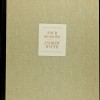In Brief
| Subtitle: | on wove after a cahier of sketches by Matisse - authentic - framed |
| Product ID: | 555ART |
| Artist: | Henri Matisse (1869-1954) |
| Nationality: | French |
| Title: | Portrait d'une Femme |
| Type: | Paper: wove |
| Date: | 1940s |
| Signed: | Initials inscribed by the artist |
| Size: | Size of visible image: 10.6 inches x 8 inches | Size of frame: 18 inches x 21 inches |
| Condition: | Excellent |
Interested in this item?
Contact us if you would like to purchase or find out more about this item
Telephone (UK)020 7127 0449
07882 539667
Telephone (International)+44 (0)20 7127 0449
+44 7882 539667
Email[email protected]
Arrange a viewingPlease call to arrange a viewing in Central London
Henri Matisse - ‘Portrait d’une Femme’ original lithograph - c1940s
on wove after a cahier of sketches by Matisse - authentic - framed
This is a beautiful original lithograph of 'Portrait d'une Femme' by Henri Matisse. The lithograph dates from the 1940s and is guaranteed to be authentic and a genuine original lithograph, not any kind of offest print. The lithograph is on wove after a cahier of sketches by Matisse (subject no. 33, cahier no. 751). The artists initials are inscribed and the piece is in excellent condition and beautifully framed. The frame is hand made from high-grade materials by a specialist Italian frame maker and would cost hundreds of pounds alone.
Provenance
Private collection of Stephen Baring. Collection includes two inherited collections and twenty five years of personal collecting. The collection numbers well over 1,000 works of art and a number will be sold over the coming weeks to fund a project. The piece comes complete with a statement of authenticity.
Lithograph
Lithography (from Greek λίθος - lithos, 'stone' + γράφειν - graphein, 'to write') is a method for printing using a stone (lithographic limestone) or a metal plate with a completely smooth surface. Invented in 1796 by German author and actor Alois Senefelder as a cheap method of publishing theatrical works, lithography can be used to print text or artwork onto paper or other suitable material.
Lithography originally used an image drawn (etched) into a coating of wax or an oily substance applied to a plate of lithographic stone as the medium to transfer ink to a blank paper sheet, and so produce a printed page. In modern lithography, the image is made of a polymer coating applied to a flexible aluminium plate. To print an image lithographically, the flat surface of the stone plate is roughened slightly—etched—and divided into hydrophilic regions that accept a film of water, and thereby repel the greasy ink; and hydrophobic regions that repel water and accept ink because the surface tension is greater on the greasy image area, which remains dry. The image can be printed directly from the plate (the orientation of the image is reversed), or it can be offset, by transferring the image onto a flexible sheet (rubber) for printing and publication.
As a printing technology, lithography is different from intaglio printing (gravure), wherein a plate is either engraved, etched, or stippled to score cavities to contain the printing ink; and woodblock printing, and letterpress printing, wherein ink is applied to the raised surfaces of letters or images. Most types of books of high-volume text are printed with offset lithography, the most common form of printing technology. The word lithography also denotes photolithography, a microfabrication technique used in the microelectronics industry to make integrated circuits and microelectromechanical systems.
A genuine, rare original lithograph by a famous listed artist that will be much admired in your home or office. Will provide an excellent financial investment as well as a possession to enjoy. You are welcome to return for a full refund if you are not entirely happy. Also, please feel free to view at our central London showroom.



